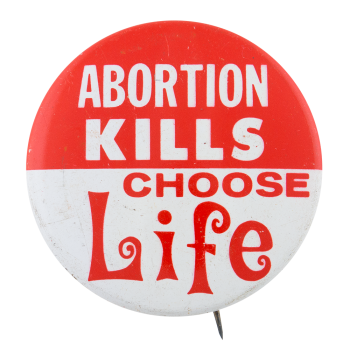| Category | |
|---|---|
| Additional Images | |
| Sub Categories | |
| Text on Button | ABORTION KILLS CHOOSE Life |
| Image Description | Red background on the top half with white text and a white background with red text |
| Curl Text | copyright 1970 PENNA. FOR HUMAN LIFE INC. |
| Back Style | |
| The Shape | |
| The Size | |
| Year / Decade Made | |
| Additional Information | The anti-abortion or "pro-life" movement began as a response to the rise of second-wave feminism in the 1960s, in which feminists argued that abortion's illegality removed a woman's autonomy over her own body. Several states including Pennsylvania, California, and Massachusetts started chapters of the National Right to Life Committee (NRLC) by 1970 in order to monitor abortion legislation. The movement did not truly gain national prominence until 1973 when the Supreme Court ruled in Roe v. Wade that a woman's right to an abortion could not be restricted by the government. The landmark case was a major blow to the pro-life movement, and motivated anti-abortion activists to mobilize and transform abortion into a political issue. The pro-life movement has been overwhelmingly Christian, and is governed by the belief that life begins at conception and abortion results in the termination of that life. Throughout the 1970s, the NRLC and other pro-life organizations attempted to pass several bills that would have reversed the Supreme Court's ruling but were unsuccessful. Today, their goals involve state-by-state legislation limiting the situations in which abortions are possible with the ultimate goal still being the repeal of Roe v. Wade. |
| Sources |
Karrer, R. (2011). The Pro-Life Movement and Its First Years under "Roe". American Catholic Studies, 122(4), 47-72. www.jstor.org/stable/44195373 |
| Catalog ID | CA0367 |


